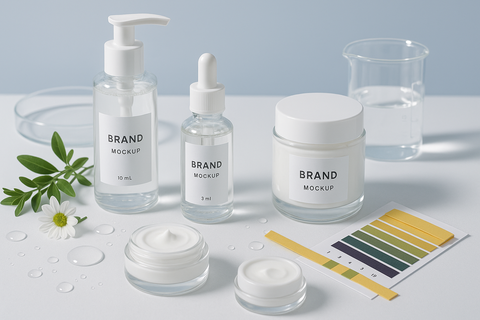You’ve likely seen “pH balanced” on a skin care label. But what does it really mean?
pH stands for “potential of hydrogen.” It measures how acidic or alkaline something is on the pH scale, which ranges from 0 to 14.
Your skin's natural pH sits slightly on the acidic side—between 4.5 and 5.5. This acidity protects the skin barrier and keeps skin healthy.
The acid mantle, a thin layer made of natural oils and sweat, plays a key role in this protection. It helps shield the stratum corneum (your skin's outer layer) from environmental stressors like pollution, bacteria, and free radicals.
When your skin’s pH balance is off, you may see dryness, irritation, or breakouts. Using harsh products, stress, or even weather can shift your skin pH.
Understanding the role of pH in skin health
Maintaining the right pH levels is essential for good skin health. It helps preserve the skin’s barrier function and supports the skin microbiome.
The skin microbiota—good bacteria on the skin—needs a specific pH to thrive. Disrupting it can lead to common skin conditions like acne, redness, or sensitivity.
Hydrating body cleansers and micellar water cleansers are often made to match your skin’s natural pH. These gentle products avoid harsh ingredients like sodium lauryl sulfate, which can damage the skin surface pH.
Tools like litmus strips or wearable pH sensors can help you monitor your skin surface pH. They’re especially useful if you use strong actives or exfoliants.
How formulators approach cosmetic formulations
Cosmetic formulations need careful pH control. A cosmetic chemist adjusts every ingredient to make sure the final pH is safe and effective.
Water-based solutions often need pH buffers like citric acid, sodium citrate, or sodium hydroxide. These keep the formula stable over time.
Some active ingredients only work in certain pH ranges. For example, alpha hydroxy acids and beta hydroxy acids like glycolic acid, lactic acid, or salicylic acid.
Formulating a hyaluronic acid cleanser or microcrystal exfoliator requires balancing the water phase, skin secretions, and product stability. That’s why pH adjustments matter so much.
How pH impacts the skin barrier
The skin barrier is your body’s first defense. It blocks out bacteria, toxins, and environmental stressors.
When skin pH shifts too far, it weakens the barrier. This can lead to flaking, redness, or a higher risk of irritation.
Supporting the barrier means using formulas with the right pH and the right ingredients. Humectants like hyaluronic acid and natural soothers like colloidal oatmeal help a lot.
Some products also use inulin compound to support the microbiome. This helps skin cells stay hydrated and balanced.
Your sebum production and sebaceous secretions also affect skin pH. These factors vary depending on your skin type and daily routine.
Key pH considerations in skin care
- The skin's natural pH helps protect the acid mantle
- pH balanced products support the skin microbiome and barrier
- Ingredients like salicylic acid or lactic acid need specific pH ranges
- Buffers such as citric acid and sodium hydroxide keep formulas stable
- Final pH should be tested with litmus strips or pH sensors
Balancing act: pH and daily skin care
Your skincare routine plays a big role in your skin’s pH. Cleansing, moisturizing, and exfoliating all affect pH balance.
Choosing pH balanced products can prevent skin conditions. These products support your skin's protective layers and microbiome.
Formulas like antioxidant cleansers, resurfacing toners, and milky cleansers are often made with this in mind. They avoid reactions that come from harsh ingredients.
Things like lifestyle, diet, and even the gut-skin axis affect your skin too. So does the use of strong exfoliants or irritating products.
People with sensitive skin, or peau sensible, benefit most from a gentle approach. Watch for signs of réaction adverse and stick to simple, balanced routines.
Working with a cosmetic chemist for balanced formulations
Creating effective skin care products starts with understanding the skin's pH. Every ingredient—like glycolic acid or sodium citrate—can change the pH.
In water-based solutions, pH impacts safety and how well the product works. Even small changes can shift performance and cause skin reactions.
Whether you're making a cleanser, toner, or exfoliator, you need to think about pH adjustments. pH buffers help maintain the right balance from start to finish.
Understanding how pH ties into formulation naturelle and barrier support is key. This is true whether you're new to formulating or studying for a cosmetic science diploma.
If you’re planning to create a skin care line that’s pH balanced and effective, contact us to get started on your next product.
